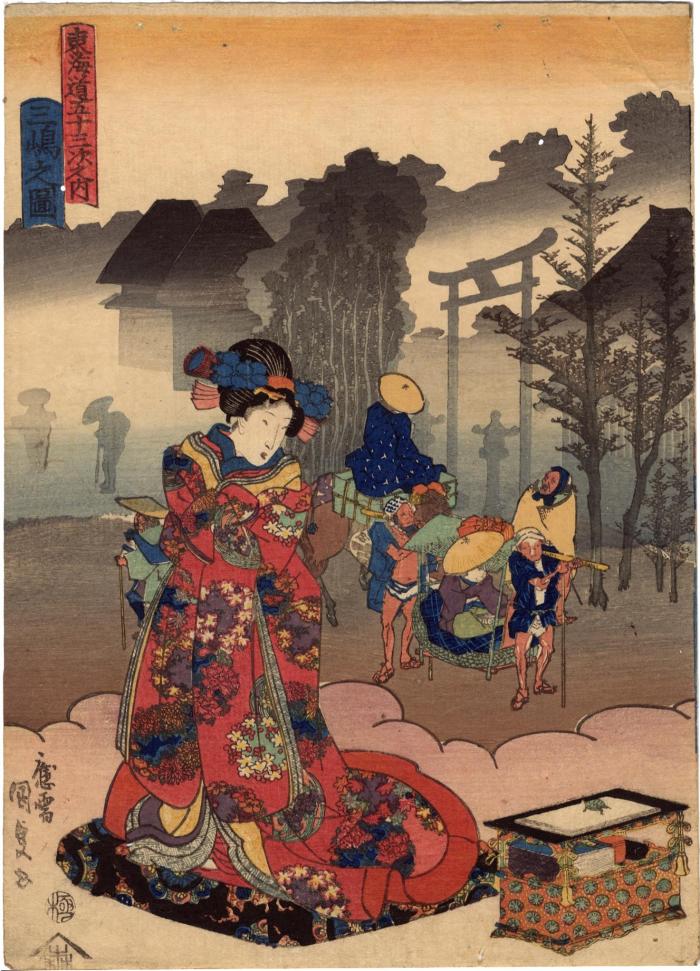Utagawa Kunisada (歌川国貞) / Toyokuni III (三代豊国) (artist 1786 – 01/12/1865)
View of Mishima (Mishima no zu - 三嶋之図) from the series Fifty-three Stations of the Tōkaidō Road (Tōkaidō gojūsan tsugi no uchi - 東海道五十三次之内)
1835
7.375 in x 10.25 in (Overall dimensions) Japanese woodblock print
Signed: ōju Kunisada ga (応需国貞画)
Publisher: Moriya Jihei
Censor's seal: kiwame
Museum of Fine Arts, Boston
National Diet Library - probably an earlier edition than the one in the Lyon Collection
Library of Congress
Honolulu Museum of Art
National Diet Library - another variant
British Museum - Hiroshige's Mishima echoed in the background of this print
Google map - Mishima
Lyon Collection - another copy of this print, but published by Sanoya Kihei
Mt. Fuji and Princess Kagiya Museum
Virginia Museum of Fine Art
Ishikawa Prefectural Museum of Art - they date their copy to 1836
Bryn Mawr
The Spencer Museum of Art
Minneapolis Institute of Art
Mishima City Local Museum (via Cultural Heritage Online)
Fujisawa Ukiyo-e Museum
Nelson-Atkins Museum Art This is number twelve in the series.
The woman is looking down contemplatively at the writing box in the lower right corner. We can't be sure, but it looks like there is a little paper weight in the shape of turtle holding down the loose sheets of paper. The woman's robe is decorated with numerous flowers, among them irises, and autumn leaves. She is standing on a large, black zabuton, a flat floor cushion used when sitting or kneeling.
****
Illustrated in color in Kunisada's Tōkaidō: Riddles in Japanese Woodblock Prints by Andreas Marks, Hotei Publishing, 2013, p. 65, #T24-12.
In a description of the original Hiroshige print of this scene in the catalogue of the Michener Collection it says: "A sense of melancholy pervades the a station Mishima in morning mist. The figure of a man on horseback wearing a hat is isolated from his servants and fellow travelers. His bundled manner suggests that he is shivering in the early morning cold. The group, which along with travelers on foot and horse includes one in a palanquin, is passing by the torii gate of Mishima Shrine. The background is silhouetted tones of ai blue and grey. Mishima Shrine was sacred to samurai during the Kamakura period (1185-1333). It was at this shrine that Yoritomo decided on a course of action that would inaugurate a seven-century rule of the shogunate."
****
The original Tōkaidō was established by the Kamakura bakufu (1192-1333) to run from Kamakura to the imperial capital of Kyoto.
****
The 'ōju' (応需) of the signature means 'by request'. Was this a special request by the publisher? Or was it a special request by a patron? We don't know? But what we do know is that it is a series that is out of the ordinary.
****
In Tokaido Landscapes: The Path from Hiroshige to Contemporary Artists, 2011, #12, p. 24, speaking of the original Hiroshige print it says: "The torii gate of the shrine of Mishima Myōjin (now Mishima Taisha) appears in silhouette. A group leaves the Mishima station early in the morning, heading for the Hakone Pass. As indicated in the subtitle, morning mist envelops the houses in the background and the three travelers on the left. Normally, in ukiyo-e prints, the outlines of objects are first printed in black and colors are added with additional blocks. But this print employs a novel method: no outlines are used for the objects in the background, which are represented solely by the planes of color."
****
The origin of the name of Mishima is given in Tōkaidō Texts and Tales: Tōkaidō gojūsan tsui by Kuniyoshi, Hiroshige, and Kunisada, edited by Andreas Marks, University Press of Florida, 2015, on page 62. It is from a translation of the title-fan cartouche. "The deity Ōyamatsumi-no-mikoto was enshrined here in the fifth year of Tenpyō (733) and is worshipped under the name Mishima Myōjin, when the station of Mishima derives its name. Ōyamatsumi is known as the deity of rain, and poems offered to him by Nōin Hōshi praying for rain, and by Mitsuhiro praying for the ceasing of rain, have proved efficacious. The shrine is indeed magnificent, and its sacred precincts tower into the sky. Ever since Ōyamatsumi's enshrinement here more than one thousand years ago people have continued to revere his divine grace."
****
In Hokusai and Hiroshige: Great Japanese Prints from the James A. Michener Collection, Honolulu Academy of Arts Yoko Woodson wrote on page 174 about the apparent chill of the morning air in the Hiroshige print. Even the groom for the horse has wrapped himself in a straw mat.
Woodson also notes that the shrine at Mishima is the place where in 1180 that Minamoto no Yoritomo (1147-1199) swore to defeat the Taira clan.
Moriya Jihei (森屋治兵衛) (publisher)
landscape prints (fūkeiga 風景画) (genre)
beautiful woman picture (bijin-ga - 美人画) (genre)
